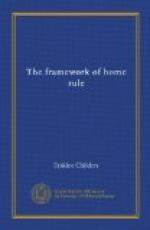{Estate Duties 914,000 914,000
Direct Taxation{Stamps 309,500 333,000
{Income Tax 1,106,500 1,307,500
{Land Value Duties 1,000 1,000
Total Direct Taxation 2,331,000 2,555,500
Total Tax Revenue 10,410,000 8,737,500
NON TAX REVENUE (1910 11).
Postal Service 935,000
935,000
Telegraph Service 185,500
185,500
Telephone Service 35,000
35,000
Crown Lands 24,000
24,500
Miscellaneous 114,500
114,500
Total Non Tax Revenue (1910 11) 1,294,500 1,294,500
Collected “True” or Revenue “Contributed” at the Revenue at the Present Day. Present Day,
Aggregates 11,704,500 10,032,000
The two aggregate figures at the bottom, L11,704,500 and L10,032,000, approximately represent the Treasury estimate of the “collected” and the “true” revenue of Ireland, respectively, at the present day. They are confirmed by the figures of previous years; for the average revenue of the five years, 1904-09, was as follows: “collected,” L11,320,000; “true” or “contributed,” L9,612,400, the new taxation of 1909-10 having added L500,000 to the “true” revenue. I must again remind the reader, however, that the figures are open to the criticism that the adjustment between the “collected” tax revenue and the “true” revenue is inaccurate owing to the methods employed by the Treasury. It will be observed that the resulting net deduction from the “collected” tax revenue of to-day, a deduction attributable, on the balance of the various figures, almost exclusively to Excise,[133] and mainly to the Excise duty on spirits, amounts to L1,672,500, and makes all the difference between the solvency and insolvency of Ireland regarded as an independent financial unit. Her expenditure, it will be remembered, was L11,344,500, her “collected” revenue L11,704,500, leaving a surplus of L360,000, which becomes a deficit of L1,312,500 if we reckon only the “true” or “contributed” revenue of L10,032,000. On the other hand, the principle, as distinguished from the methods of adjustment, is perfectly sound if we wish to arrive at a correct idea of the financial position of Ireland. The L1,672,500 virtually represents the duties on goods exported from Ireland, and consumed in Great Britain, or rather the excess of these duties over those levied on goods exported from Great Britain and consumed in Ireland. The consumer pays the tax on dutiable commodities, and a financially independent Ireland could not raise revenue twice over from the same commodity. She would, for example, have to give a drawback from the Excise duty on spirits exported to England, since a Customs duty would be levied on its import into England. On the other hand, she would be entitled to every penny of revenue derived from the tea and sugar imported into and consumed within her borders, and to the full income tax on property held by Irishmen.




